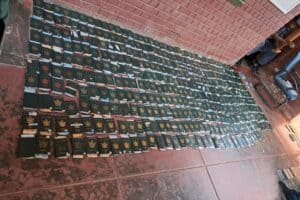The heavy figurines -- some standing at about 1.5 metres -- were moved from an on-site museum and placed outdoors on pedestals for a photo shoot.

They figure on Zimbabwe’s national flag, banknotes and official documents — birds representing stone statues taken by colonialists more than a century ago.
The eight original sculptures hold great spiritual value for people of the southern African nation and have been made into national emblems.
Six of the large carvings were stolen from the ruins of Great Zimbabwe, an imposing stone complex built between the 11th and 13th centuries and attributed to pre-colonial King Munhumutapa.

A sculpture of a bird carved from soapstone was temporarily moved from a museum at the same site to be placed back in its original position at the Great Zimbabwe monument near Masvingo on February 20, 2020. Picture: Jekesai NJIKIZANA / AFP
The palatial enclosures are now a UNESCO world heritage site situated in the southeast of Zimbabwe, 25 kilometres (16 miles) from the present day city of Masvingo.
Almost all of the prized green-grey soapstone birds that were looted have now been returned to the country.
Only one remains in South Africa, where it is kept in the house of 19th century British mining magnate and imperialist Cecil Rhodes.
In a rare move last month, four of the statues were temporarily set on the original plinths from where they were stolen at the Great Zimbabwe monument.

A tour guide leads school children past the conical tower at the Great Zimbabwe monument near Masvingo is seen on February 20, 2020. Picture: Jekesai NJIKIZANA / AFP
The heavy figurines — some standing at about 1.5 metres (4.9 feet) — were moved from an on-site museum and placed outdoors on pedestals for a photo shoot.
Their pictures were taken for a book on ancient African art – Zimbabwe: Art, Symbols and Meaning — to be published in September. The country marks the 40th anniversary of independence from Britain next month.
The book will be co-authored by a Zimbabwe-born duo, mother and son — Gillian Atherstone and Duncan Wylie — who now respectively live in Britain and France.

A sculpture of a bird carved from soapstone was temporarily moved from a museum at the same site to be placed back in its original position at the Great Zimbabwe monument near Masvingo on February 20, 2020. Picture: Jekesai NJIKIZANA / AFP
“The birds are among the most symbolic cultural objects of our time,” the head of Zimbabwe’s national museums Godfrey Mahachi, told AFP.
“They connect the present with our past.”
Great Zimbabwe ruins curator Munyaradzi Sagiya said the statues are kept inside the museum for security reasons.
“Not everyone who visits a museum is there to admire the displays,” he said.

Curator of Archeology of the Great Zimbabwe monument, Munyaradzi Sagiya, walks in a corridor alongside the conical tower at the Great Zimbabwe monument near Masvingo is seen on February 20, 2020. Picture: Jekesai NJIKIZANA / AFP
Africa’s former colonial powers have recently come under pressure to send looted artefacts back to their home countries.
Germany returned the chopped off pedestal of one of the birds in 2003.
Zimbabwe’s late ex-president Robert Mugabe said at the time that the piece had “a very eventful if not troubled existence during its almost 100 years in exile.”

A sculpture of a bird carved from soapstone was temporarily moved from a museum at the same site to be placed back in its original position at the Great Zimbabwe monument near Masvingo on February 20, 2020. Picture: Jekesai NJIKIZANA / AFP
South Africa returned five other birds in 1981, one year after Zimbabwe’s independence.
The eighth remains in Rhodes’ Cape Town home.
Retrieving that statue could be complicated, said Sagiya, as Rhodes left his estate to the South African government after his death.
For more news your way, download The Citizen’s app for iOS and Android.






